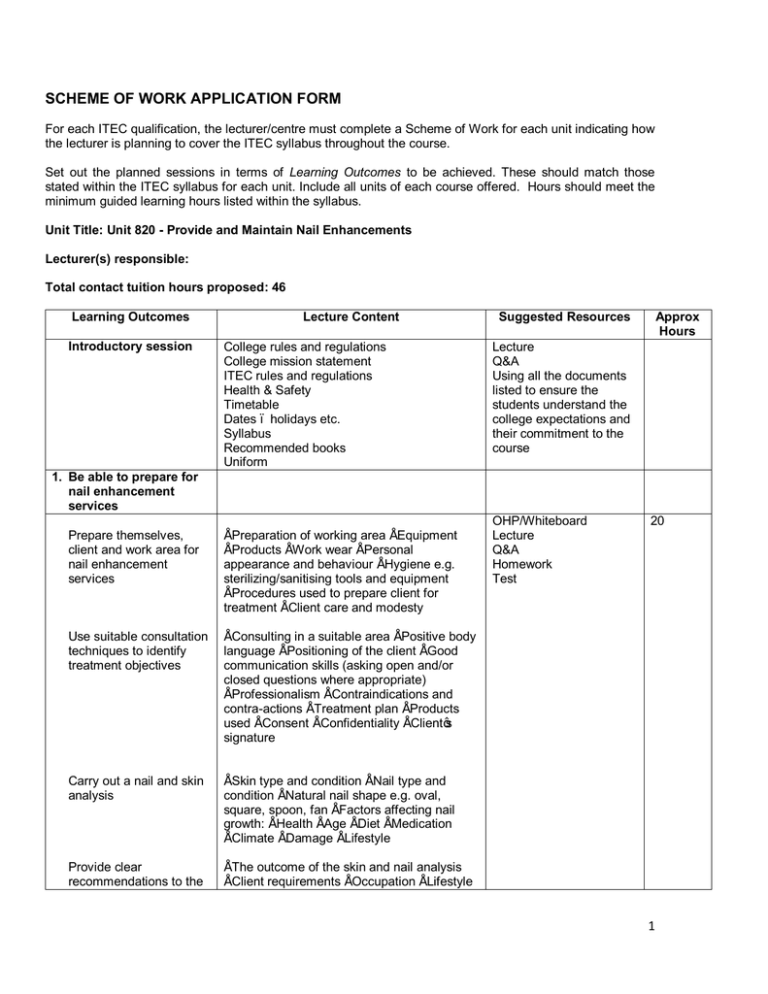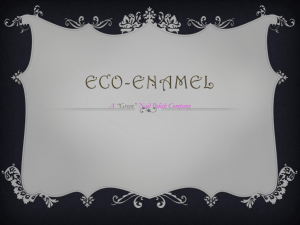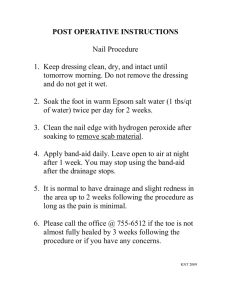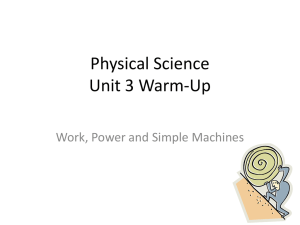SCHEME OF WORK APPLICATION FORM
advertisement

SCHEME OF WORK APPLICATION FORM For each ITEC qualification, the lecturer/centre must complete a Scheme of Work for each unit indicating how the lecturer is planning to cover the ITEC syllabus throughout the course. Set out the planned sessions in terms of Learning Outcomes to be achieved. These should match those stated within the ITEC syllabus for each unit. Include all units of each course offered. Hours should meet the minimum guided learning hours listed within the syllabus. Unit Title: Unit 820 - Provide and Maintain Nail Enhancements Lecturer(s) responsible: Total contact tuition hours proposed: 46 Learning Outcomes Introductory session Lecture Content College rules and regulations College mission statement ITEC rules and regulations Health & Safety Timetable Dates – holidays etc. Syllabus Recommended books Uniform Suggested Resources Approx Hours Lecture Q&A Using all the documents listed to ensure the students understand the college expectations and their commitment to the course 1. Be able to prepare for nail enhancement services Prepare themselves, client and work area for nail enhancement services • Preparation of working area • Equipment • Products • Work wear • Personal appearance and behaviour • Hygiene e.g. sterilizing/sanitising tools and equipment • Procedures used to prepare client for treatment • Client care and modesty Use suitable consultation techniques to identify treatment objectives • Consulting in a suitable area • Positive body language • Positioning of the client • Good communication skills (asking open and/or closed questions where appropriate) • Professionalism • Contraindications and contra-actions • Treatment plan • Products used • Consent • Confidentiality • Client’s signature Carry out a nail and skin analysis • Skin type and condition • Nail type and condition • Natural nail shape e.g. oval, square, spoon, fan • Factors affecting nail growth: • Health • Age • Diet • Medication • Climate • Damage • Lifestyle Provide clear recommendations to the • The outcome of the skin and nail analysis • Client requirements • Occupation • Lifestyle OHP/Whiteboard Lecture Q&A Homework Test 20 1 client • Current regime • Identification of the appropriate nail enhancement system • Recommendations for ongoing maintenance treatments and the level of commitment required Select products, tools and equipment to suit client treatment needs, skin types and nail conditions • Couch or chair • Trolley or manicure table • Stool • Magnifying lamp • Towels • Additional support if appropriate • Bedroll • Disinfecting fluid • Tissues • Lint Free Pads • Sterilising solution • UV cabinet • Autoclave • Hot bead steriliser • Chemical immersion equipment • Waste disposal • Files • Buffers • Brushes appropriate to the system • Orange wood stick • Cuticle tools • Clippers • Scissors • Appropriate light source i.e. UV or LED • Nail tips • Covered dappen dish • Natural nail cleanser • Nail preparation products • Adhesives • Oils • Acetone free nail polish remover • Acetone • Base cost • Top coat • Enamel Products for one of the following nail enhancement systems: • Liquid and powder • Gel • Wraps Describe salon requirements for preparing themselves, the client and the work area • Any particular rights, restrictions and Acts applicable to nail enhancement services • Record keeping • Code of practice/ethics • Insurance and professional association membership • Professional appearance Describe the environmental conditions suitable for nail enhancement services • Lighting • Heating • Ventilation • Protective equipment • Noise Levels • Available space • Music • General hygiene • Waste disposal • Décor • Equipment • Privacy • Reception areas • General use/treatment areas Describe different consultation techniques used to identify treatment objectives • Positive body language • Positioning of the client (no barriers between themselves and client) • Good communication skills (asking open and/or closed questions where appropriate) • Verbal and non-verbal communication Explain the importance of carrying out a detailed nail and skin analysis • Skin type and condition • Nail type, shape and condition • Contraindications • Scope of treatment(s) • Identification of nail enhancement system suitability • Home care advice • Aftercare advice Describe how to select products, tools and equipment to suit client treatment needs, skin and nail conditions • Couch or chair • Trolley or manicure table • Stool • Magnifying lamp • Towels • Additional support if appropriate • Bedroll • Disinfecting fluid • Tissues • Lint Free Pads • Sterilising solution • UV cabinet • Autoclave • Hot bead steriliser • Chemical immersion 2 equipment • Waste disposal • Files • Buffers • Brushes appropriate to the system • Orange wood stick • Cuticle tools • Clippers • Scissors • Appropriate light source i.e. UV or LED • Nail tips • Covered dappen dish • Natural nail cleanser • Nail preparation products • Adhesives • Oils • Acetone free nail polish remover • Acetone • Base cost • Top coat • Enamel Products specific for Liquid and Powder System: • Liquid monomer • Powder polymer Products specific for Gel System: • Gel Oligomers • Gel Cleanser • Gel Sealer/Top Coat Products specific for Wrap System: • Wrap fabrics • Resin (brush or nozzle) • Activator (brush or spray) Nail enhancement techniques to include one of the following nail enhancement systems: • Liquid and powder • Gel • Wraps • The methods, hygiene and safety precautions, effects and benefits of all treatment techniques for chosen system Identify nail and skin conditions Describe the contraindications which prevent or restrict nail enhancement services • Beau’s lines • Bitten nails • Blue nail • Brittle nails • Bruised nails • Discoloured nails • Dry nails • Flaking nails • Hang nails • Koilonychia • Lamella Dystrophy • Leuconychia • Misshapen nails • Mould • Onychatrophia • Onychauxis • Onychia • Onychocryptosis • Onychogryphosis • Onycholysis • Onychomycosis (Tinea Ungium) • Onychophagy • Onychophyma • Onychoptosis • Onychorrhexis • Paronychia (Whitlow) • Pitting • Pterygium • Sepsis • Split nails • Transverse ridges • Vertical ridges • Weak nails • Mature skin • Young skin • Sensitive skin • Dehydrated skin • Dry skin • Dermatitis • Eczema • Psoriasis • Corns • Chilblains • Warts • Verrucae Contraindications requiring medical permission – in circumstances where medical permission cannot be obtained clients must sign an informed consent form stating that the treatment and its effects have been fully explained to them and confirm that they are willing to proceed without permission from their GP: • Haemophilia • Any condition already being treated by a GP, dermatologist or another practitioner • Acute arthritis • Nervous or Psychotic conditions • Recent operations on the area • Diabetes • Undiagnosed pain • Acute rheumatism 3 Contraindications that restrict treatment: • Fever • Infectious or contagious diseases • Infectious or contagious diseases of the skin and nails • Under the influence of recreational drugs or alcohol • Diarrhoea and vomiting • Any known allergies • Undiagnosed lumps and bumps • Inflammation • Cuts • Bruises • Abrasions • Scar tissue (2 years for major operations and 6 months for a small scar) • Recent fractures (minimum 3 months) • Sunburn • Repetitive strain injury • Carpal Tunnel Syndrome • Loss of skin sensation • Severely bitten/damaged nails • Nail separation • Eczema • Psoriasis • Dermatitis • Broken bones 2. Be able to provide nail enhancement services Communicate and behave in a professional manner • Explanation of treatment • Benefits, limitations and co-operation required • Client care, modesty and support • Communication • Correct posture, hygiene and a professional approach to the client throughout treatment Follow health and safety working practices and Industry Code of Practice for nail services • Fire Precautions Act • Health & Safety at Work Act • Health and Safety (First Aid) Regulations • The Management of Health & Safety at Work Regulations • The Workplace (Health, Safety & Welfare) Regulations • The Manual Handling Operations Regulations • The Personal Protective Equipment at Work Regulations • The Provision and Use of Work Equipment Regulations • The Control of Substances Hazardous to Health Regulations (COSHH) • The Electricity at Work Regulations • Reporting of Injuries, Diseases and Dangerous Occurrences Regulations (RIDDOR) • Disability Discrimination Act • Data Protection Act • Adhere to all product safety precautions and manufacturers’ instructions • Legislation which relates to the work being carried out, the environment and the client with whom the nail technician is working • Industry Code of Practice for nail services Position themselves and client correctly throughout the service • Ensuring the client is comfortable and correctly supported • Nail technician maintaining correct working posture throughout treatment • Nail technician selfcare Use products, tools, equipment and Equipment OHP/Whiteboard Lecture Q&A Handout: Homework Test 26 4 techniques to suit client’s service needs, nail and skin conditions • Couch or chair • Trolley or manicure table • Stool • Magnifying lamp • Towels • Additional support if appropriate • Bedroll • Tissues • Lint Free Pads • UV cabinet • Autoclave • Hot bead steriliser • Chemical immersion equipment • Waste disposal • Files • Buffers • Brushes appropriate to system • Orange wood stick • Cuticle tools • Clippers • Scissors • Appropriate light source i.e. UV or LED • Covered dappen dish Products • Disinfecting fluid • Sterilising solution • Nail tips • Adhesives • Oils • Natural nail cleanser • Nail enamel remover • Acetone • Nail preparation products • Base coat • Topcoat • Enamel Products for Liquid and Powder System: • Liquid monomer • Powder polymer Products specific for Gel System: • Gel Oligomers • Gel Cleanser • Gel Sealer/Top Coat Products specific for Wrap System: • Wrap fabrics • Resin (brush or nozzle) • Activator (brush or spray) Nail enhancement techniques to include: • Nail preparation • Tip Selection • Tip Tailoring and Application • Blending • Overlay Selection and Application • Curing Procedure (Activator or appropriate light source) where applicable • Filing and finishing of chosen nail enhancement system as appropriate Complete the service to the satisfaction of the client • Conclusion of service in appropriate manner to meet client’s needs, manufacturers’ instructions and nail enhancement system specification • Check service results with client Record the results of the service • Client response to service and feedback • Note benefits of the nail enhancement service • Product advice • Home care advice • Store records demonstrating knowledge of confidentiality requirements Provide suitable aftercare advice • Recommendations for immediate aftercare and treatment maintenance • Product recommendations • Lifestyle • Recommendation of further salon treatments including removal State how to communicate and behave in a professional manner • Consultation • Treatment explanation • Client care • Hygiene • Good communication skills 5 Describe health and safety working practices and Industry Code of Practice for Nail Services • Fire Precautions Act • Health & Safety at Work Act • Health and Safety (First Aid) Regulations • The Management of Health & Safety at Work Regulations • The Workplace (Health, Safety & Welfare) Regulations • The Manual Handling Operations Regulations • The Personal Protective Equipment at Work Regulations • The Provision and Use of Work Equipment Regulations • The Control of Substances Hazardous to Health Regulations (COSHH) • The Electricity at Work Regulations • Reporting of Injuries, Diseases and Dangerous Occurrences Regulations (RIDDOR) • Disability Discrimination Act • Data Protection Act • Industry Code of Practice for nail services Explain the importance of positioning themselves and the client correctly throughout the service • Ensuring the client is comfortable and correctly supported • Nail technician maintaining correct posture throughout treatment Explain the importance of using products, tools, equipment and techniques to suit client’s service needs, nail and skin conditions • Couch or chair • Trolley or manicure table • Stool • Magnifying lamp • Towels • Additional support if appropriate • Bedroll • Disinfecting fluid • Tissues • Lint Free Pads • Sterilising solution • UV cabinet • Autoclave • Hot bead steriliser • Chemical immersion equipment • Waste disposal • Files • Buffers • Brushes appropriate to the system • Orange wood stick • Cuticle tools • Clippers • Scissors • Appropriate light source i.e. UV or LED • Nail tips • Covered dappen dish • Natural nail cleanser • Nail preparation products • Adhesives • Oils • Acetone free nail polish remover • Acetone • Base cost • Top coat • Enamel Nail enhancement products and techniques to include one of the following: • Liquid and powder • Gel • Wraps Describe how nail services can be adapted to suit client service needs, nail and skin conditions • Restrictions – contraindications and contraactions • Nail shapes, types and conditions • Skin condition • Client preferences and commitment • Product availability and suitability • Time scales • Costs • Adapting the treatment to suit the needs of the client Describe how to maintain and remove nail enhancements • Rate and process of nail growth • After care and home care advice specific to system • Infilling • Rebalancing • Replacement of overlay • Repair of overlay • Identification of correct removal method • Removal procedure 6 timings • Removal procedures specific to nail enhancement system State the contra-actions that may occur during and following service and how to respond State the importance of completing the service to the satisfaction of the client State the aftercare advice that should be provided Describe the chemical process involved in the nail enhancement system Describe the structure and functions of the nail and skin • Excessive erythema • Skin irritation • Exothermic reaction • Allergic reaction • Itching • Inflammation • Lifting • Premature Loss of Enhancement • Ridging • Shedding • Separation • Infection • Hang nail • Overexposure • Client abuse; Biting/picking • Damaged cuticle • Holes in nail plate • Bacterial infection of the nail • Dehydration • Mould • Discolouration • Sepsis • Loss of Natural Nail • Immediate removal of product • Cold purified water • Referral procedures • Concluding the service in appropriate manner to meet client’s needs, manufacturers’ instructions and nail enhancement specification • Check service results with client ▪ Maintaining records ▪ Compliance with Data Protection • Recommendations for immediate aftercare • Recommendations for treatment maintenance and home care • Recommendations for use of specialised products if applicable • Lifestyle • Recommendations for further salon treatments • Recommendations regarding maintenance and removal • Polymerisation • Exothermic effect • Light curing • Light sources • Appropriate timings • Lamp wattage, positioning and safety • Activators and Accelerators • Initiators • Monomers • Polymers • Oligomers • Primers • Solvents The Nail • Free edge • Hyponychium • Eponychium • Peronychium • Lunula • Mantle • Cuticle • Nail plate • Nail bed • Nail fold • Matrix • Nail wall • Nail growth • Protection The Skin Epidermis • Stratum Corneum • Stratum Lucidum • Stratum Granulosum • Stratum Spinosum/Malphigian • Stratum Germinativum/Basal Layer Dermis • Blood supply • Lymphatic supply • Hair follicle • Hair • Sebaceous gland • Sweat gland: Eccrine and Apocrine • Sensory nerve endings • Dermal papilla • Collagen • Elastin • Histiocytes • Mast cells 7 • Fibroblasts • Erector pili muscle • Melanocytes Subcutaneous/Adipose Layer • The fatty layer underneath the Dermis Functions: • Secretion • Heat regulation • Absorption • Protection/Acid Mantle (composition and formation) • Elimination/excretion • Sensation • Vitamin D formation (7-dehydro-cholesterol) Describe the different nail shapes • Fan • Hook • Oval • Pointed • Round • Ski Jump/Spoon • Square Mock Practical To include full treatment Mock Theory To include all the theory Mock theory paper 8






